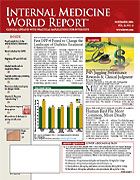Publication
Article
Internal Medicine World Report
Myriad Benefits of High Vitamin D Intake: The New "Miracle Drug"?
Author(s):
Hypovitaminosis D Prevalent Even in Florida
PHILADELPHIA—If the sentiment among physicians at the recent American Society of Bone and Mineral Research annual meeting is any indication, the many Americans with vitamin D deficiency would benefit greatly from supplementation.
Bruce R. Troen, MD, of the University of Miami Miller School of Medicine and the Miami VA Medical Center, says hypovitaminosis D is prevalent even in Florida, whose motto is “the sunshine state.”
He explains that hypovitaminosis D does not mean frank deficiency, but rather vitamin insufficiency. Discussing the desired and deficient serum levels of vitamin D, Dr Troen said, “If you’re <30 ng/mL (75 nM), then you’re probably at increased risk for a bunch of bad things happening.” He refers to studies by Michael F. Holick (Am J Clin Nutr. 2004; 80:1678S-1688S) and others who have demonstrated that hypovitaminosis D is a common condition throughout North America and in all age-groups.
“There’s a huge epidemic of hypovitaminosis D, and the real key here is not just that it’ll benefit you from a bone and neuromuscular standpoint, but if you correct hypovitaminosis D and the corresponding secondary hyperparathyroidism, then you’re going to decrease prostate cancer, colon cancer—actually “up to 17 different cancers, breast cancer included,” Dr Troen says.
He also lists improved insulin sensitivity, a decrease in the pain associated with certain syndromes (eg, osteoarthritis), and a lower incidence of congestive heart failure and hypertension, among other benefits.
According to Dr Troen, hypovitaminosis D osteopathy is a major concern. The most severe form, rickets, can be avoided with “a couple hundred units” of vitamin D a day. He maintains, however, that the US government’s recommended daily intake of 400 IU/day is not enough to avoid the long-term effects of insufficiency, which is why he postulates that most patients being treated for osteoporosis are not achieving an optimal response.
Reviewing 2 articles published in the Journal of the American Geriatrics Society: one on parathyroid hormone levels in the elderly (2006; 54:782-789) and the other on risedronate treatment for elderly nursing home patients (2006; 54:790-795), Dr Troen wrote an editorial (2006; 54:853-855) suggesting that one reason for the failure of risedronate therapy (in the second study) was that the patients were not getting enough vitamin D, despite receiving 400-IU/day supplementation.
He recommends that primary care physicians make sure that all their patients who are receiving antiresorptive agents for osteoporosis are replete with vitamin D.
An intake of around “a couple thousand units” a day for most patients would result in a serum level of 30 to 32 ng/mL. The Women’s Health Initiative study (N Engl J Med. 2006; 354: 669-683) showed that women who were 80% compliant in taking 400 units of vitamin D daily plus calcium “had a statistically significant reduced odds ratio for hip fracture…and yet their average vitamin D levels were still only…somewhere around 20 ng/mL.”
Unless a patient has a predisposing condition, such as primary hyperparathyroidism or is at risk of forming calcium stones, Dr Troen contends that it is almost impossible to take too much vitamin D. “You can give 10,000 units a day for months. Nothing bad will happen.”
In Europe, physicians administer 300,000 units intramuscularly (IM) without ill effects. A study published in the Medical Journal of Australia (2005; 183:10-12) of 5 men and 45 women (mean age, 66.3) with vitamin D sufficiency reported that an IM injection of 600,000 units of cholecalciferol normalized vitamin D levels in all patients. In addition, the dose was safe, with only 2 patients developing mild hypercalcemia at 12 months.
Beyond bone health, supplementing vitamin D at levels far higher than are now commonly used offers multiple advantages at little risk or expense. Dr Troen reports that he takes 2000 units a day and recommends this dose for his adult family members. “If you want to stay healthy…vitamin D is one way to help at least diminish your chances of getting a lot of bad diseases.”
Evidence is accumulating in this area, with studies linking vitamin D to the prevention of cancer and autoimmune and other diseases (Am J Public Health. 2006; 96:252-261; Nutr Cancer. 2004; 48: 115-123; Prog Biophys Mol Biol. 2006; 92:65-79; Altern Med Rev. 2005; 10: 94-111).
Key points
• Hypovitaminosis D is common in North America in all age-groups.
• The current recommendation of 400 IU/day is insufficient to prevent hypovitaminosis D.
• Taking adequate amounts of vitamin D can help to prevent up to 17 different cancers.






